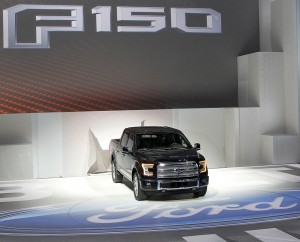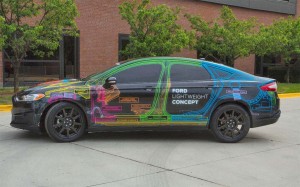
Ford's new F-150 will be up to 700 pounds lighter than the outgoing pickup truck. Photo credit: Len Katz.
When the new Ford F-150 comes to market later this year it could usher in a dramatic transformation, according to auto industry leaders, who forecast that more than 75% of all pickups will migrate to aluminum bodies over the next decade.
The payoff could be substantial in terms of both performance and capacity, as well as fuel economy, according to the report by the consulting and research firm Ducker Worldwide. The general rule of thumb is that mileage improves an average 1 mpg for every 100 pounds of weight reduction, and in the case of the new 2015 F-150, Ford expects to save up to 700 pounds per truck.
“The numbers tell a powerful story of aluminum’s explosive growth across the automotive sector,” said Tom Boney, chairman of the Aluminum Association’s Aluminum Transportation Group, which commissioned the new report.
“Within the next ten years, seven out of 10 new pickups produced in North America will be aluminum-bodied, and so too will be more than 20% of SUVs and full–sized sedans,” he predicted.
In all, the study suggests that about 18% of all vehicles produced in North America by 2025 will have aluminum bodies. As a result, demand for the lightweight metal in sheet form will surge from just 200 million pounds in 2012 to 4 billion pounds by 2025.
Not everyone is quite willing to buy into the report which clearly supports the Aluminum Association’s agenda. All eyes will be on the new F-150, long the nation’s best-selling vehicle, comes to market later this year. While the Detroit maker insists it has taken numerous steps to both ensure the durability of the new pickup, and to minimize repair costs and hassles, it remains to be seen if consumers will embrace the switch from conventional steel.
(Ford has a lot riding on aluminum as it prepares to launch the new F-150. Click Here for the story.)
Competitors like General Motors and Chrysler have adopted a skeptical stance and clearly waiting to see how Ford fares in the market. GM global product development chief Mark Reuss has indicated the maker does not plan to switch to aluminum for its next-generation Chevrolet Silverado and GMC Sierra models. And Fiat Chrysler CEO Sergio Marchionne has taken a similarly cautious position. But that could change if Ford scores a home run with the aluminum F-150.
Indeed, the industry is facing tough challenges in meeting the daunting 45.5 mpg Corporate Average Fuel Economy standards that will go into effect in 2025, and while makers are exploring a variety of options to get there – including improved aerodynamics, turbocharging and even hybridization – most analysts expect to see a concerted focus on what automotive engineers call lightweighting.
Aluminum is already finding growing demand in the automotive world. The old F-150, along with a number of other pickups, used at least some aluminum body panels. But makers are also expanding their use of new versions of traditional metals, such as hot-rolled ultra-high strength steel – which can also reduce weight at a lower cost.
And there are advanced alternatives that could give aluminum a run for the industry’s money. BMW is making extensive use of super-light carbon fiber in its new i3 and i8 battery cars – and the maker is part of a partnership that will triple the size of a plant in Washington State that is set to become the world’s largest supplier of carbon fiber.
That material has traditionally been too expensive for mainstream automotive applications but BMW and others are working on new production methods that could make carbon fiber more competitive.
Barring such a dramatic breakthrough, aluminum could prove the material of choice. And Ford already appears to be looking for opportunities beyond the F-150. It last week unveiled its Lightweight Concept vehicle, a possible aluminum-intensive version of the popular midsize Fusion sedan.
“Over time we’ll see more and more aluminum across (our) entire lineup,” CEO Alan Mulally hinted earlier this year.
(Click Here to check out the new Ford Lightweight Concept.)
Even on vehicles that continue to rely on steel, there’ll be more aluminum in the mix. The Ducker study predicts that 85% of all hoods will be aluminum by 2025, up from a third in 2012; and nearly half of all doors will use the metal, up from barely 6%.
Beyond sheet metal applications, automakers are finding a growing range of applications for aluminum in suspension, powertrain and other automotive components. As a result, the typical vehicle produced in North America last year contained around 350 pounds of the metal. That is forecast to reach 550 pounds per vehicle by 2025, according to the Ducker report.
(Fuel economy hits record level in May. Click Here for more.)



Aluminum has many desirable benefits but it comes at a price. Unfortunately aluminum body panels tend to dent easier than steel and they cost more to repair properly. Light weight composites will increase in autos as impossible to meet mpg regulations are forced on the auto industry by political arse clowns in DC.
No question, cost is an issue, Jorge. On the other hand, the metal is more ding resistant and Ford *claims* the alloys it adopted for the F-150 are less prone to dents. It apparently ran extensive field tests using substitute parts, ie beds, in older F-150s used by some of its fleets. We’ll soon see if this proves true.
Paul E,
Yeah I know all about the claims… We’ll see how that works in real life.
Mixing steel components with aluminum components is going to accelerate corrosion at their joints at a higher rate than exclusive use of one metal or the other..
Charles, we’ve been seeing steel and aluminum, as well as magnesium, used together in countless automobiles for more than a decade. You have a good chance of having an aluminum engine block in many mid-priced and more expensive models, as well as aluminum suspension components. The hoods and deck lids of many models are now aluminum, as well, while the rest of the body is usually steel. Magnesium is frequently used under the IP. The challenge is ensuring that the metals remain isolated to avoid creating a voltaic effect that results in corrosion. Makers have gotten very, very good at this, though problems occasionally do occur.
Paul A. Eisenstein
Publisher, TheDetroitBureau.com
A Camel is a horse designed by our Congress. They, Congress, were n ever to get involved into our everyday lives. If they even had a clue on how to run a business this Nation would not be Bankrupt.